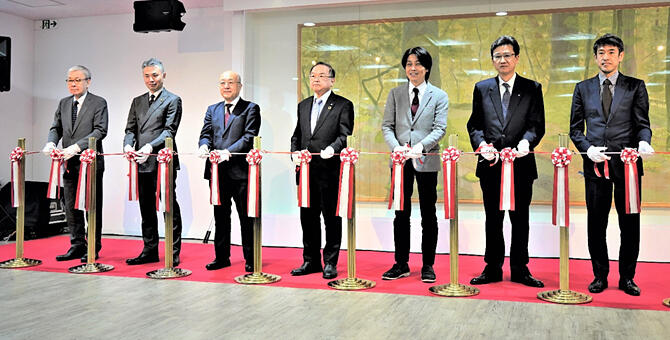The Osaka University Graduate School of Engineering, Shimadzu, Itoham Yonekyu, Toppan and SIGMAXYZ established the "Future Creation Consortium for Cultivated Meat" earlier this year. The consortium now promotes concrete efforts for the social implementation of edible cultured‐meat manufacturing using 3D bioprinting developed by Osaka University. They plan to temporarily exhibit the meat making apparatus (automated cultured meat production equipment) at the Osaka Healthcare Pavilion of the Osaka/Kansai Expo (Expo 2025 Osaka, Kansai, Japan); the plan, including the offering of cultured meat samples, will be implemented when legal and regulatory issues are resolved. They are also scheduled to offer commercial products to the market by approximately 2030.

Provided by Osaka University
To date, most of the cultured meat has been reported to contain a minced structure composed only of muscle fibers, and the reproduction of the complex structure of meat has been difficult. In contrast, the cultured meat technology developed by the research group of Professor Michiya Matsusaki of Osaka University initially extracts satellite cells (for muscle) and fat‐derived stem cells (for fat and blood vessels) from wagyu beef.
The extracted components are grown by cell culture, and the proliferated muscle, fat, and blood vessels are bundled with a 3D printing device to produce the structuralized and cultured meat. This technique not only reproduces the beautiful "marbling" of wagyu beef, but also makes it possible to finely adjust the fat and muscle components. In addition to meat, this technology is expected to be applied to the fields of regenerative medicine and drug discovery.
In August 2021, Osaka University and the collaborating companies published a research paper on their cultured‐meat production technology using 3D printing. Based on this technology, Osaka University, Shimadzu Corporation, and SIGMAXYZ signed a collaboration agreement in March 2022 for "The social Implementation of 3D Bioprinting Technology" and began working on its practical application.
Itoham Yonekyu, who has been an accomplished expert on meat production for many years, joined the "Future Creation Consortium for Cultivated Meat" to further accelerate the existing collaborations and technological development. Prior to the establishment of this consortium, the five parties signed an agreement in January of this year for "the social implementation of edible cultured‐meat technology using 3D printing" and established a system for their activities. Itoham Yonekyu Holdings, a new group member, provides high‐quality wagyu cells to produce cultured meat, facilitates peripheral technologies such as for taste and quality evaluation, and gives consideration to product distribution and sales. Furthermore, in conjunction with the establishment of the consortium, Osaka University, Itoham Yonekyu, and Toppan have established "Joint Research Laboratory for Social Implementation of Cultured Meat" at the Suita campus of Osaka University. This joint research course, as well as the "Osaka University Shimadzu Omics Innovation Research Laboratories" established on the same campus in December 2019, will serve as the research promotion bases for the consortium.
The five parties are planning to present the automatic manufacturing equipment to disseminate the consortium activities to the world at "The Osaka Healthcare Pavilion, Nest for Reborn" hosted by Osaka Prefecture and Osaka City at the 2025 Osaka/Kansai Expo. Moreover, they are considering providing 100 servings of cultured meat per week (approximately 5 cm²) to interested visitors produced using the 3D bioprinting technology. Through their activities at the 2025 Osaka/Kansai Expo, the consortium will present this cultured meat as a "future food" to reduce the burden on the environment and solve the global protein shortage and seek to promote public understanding.
This article has been translated by JST with permission from The Science News Ltd. (https://sci-news.co.jp/). Unauthorized reproduction of the article and photographs is prohibited.




